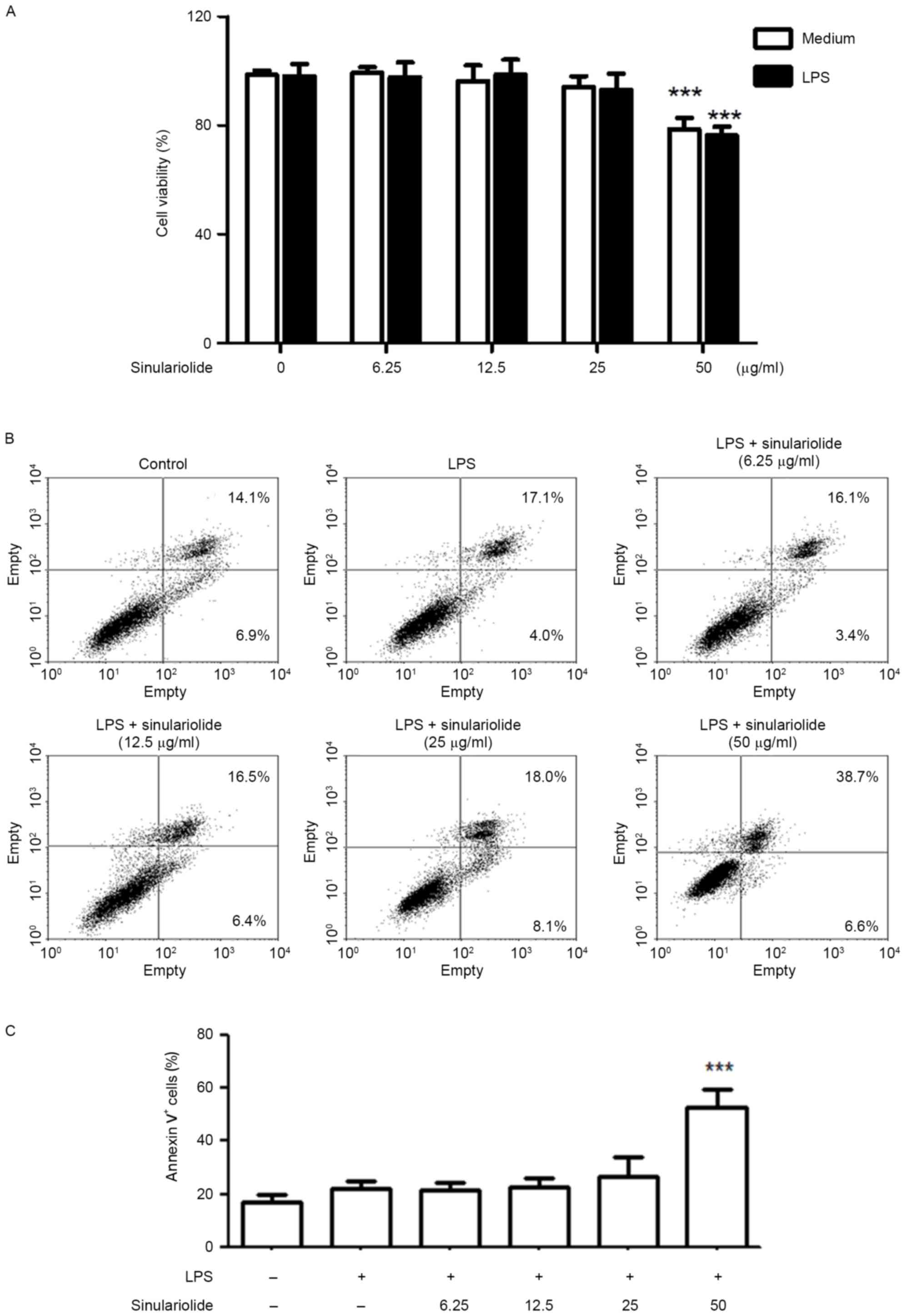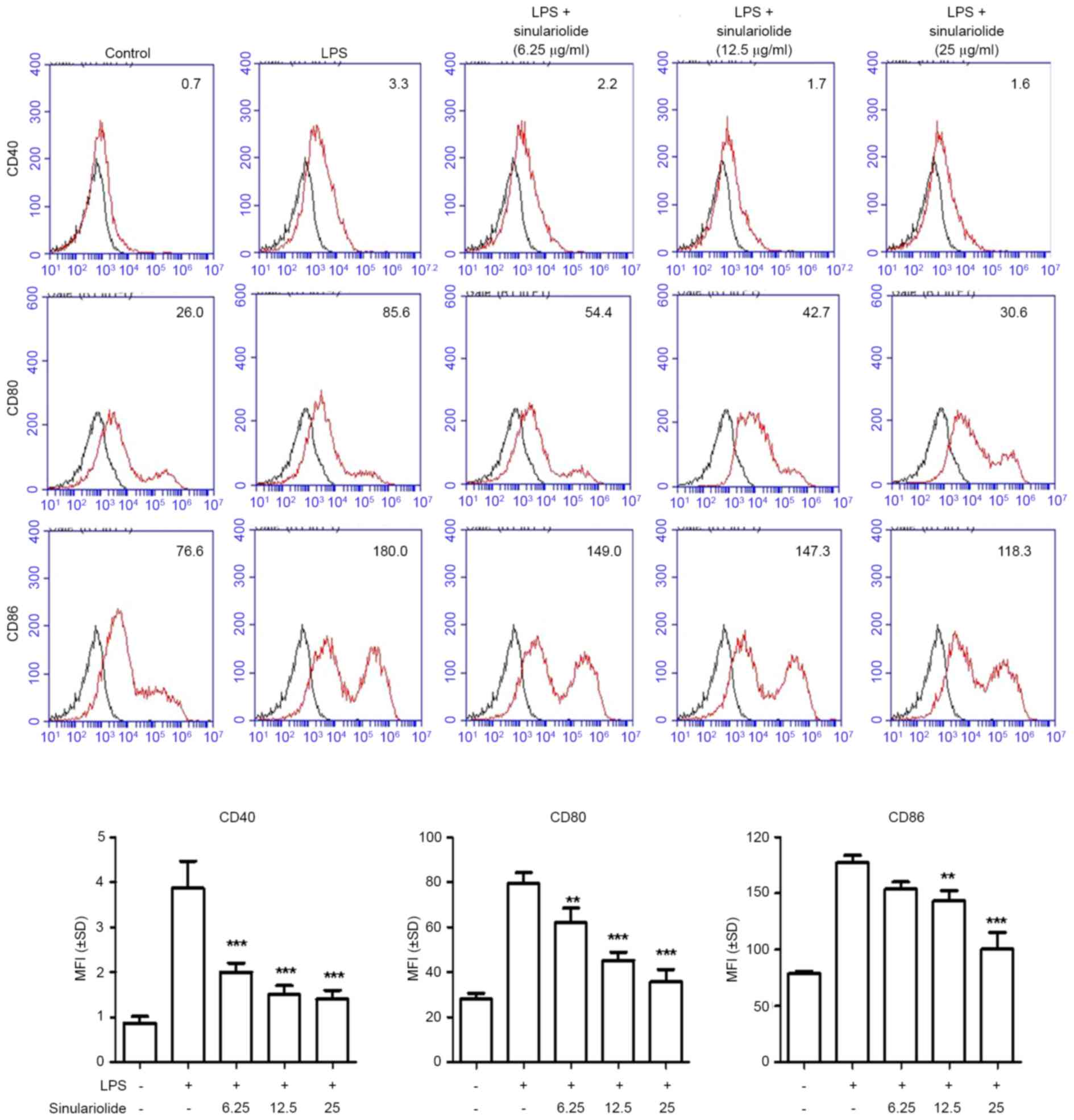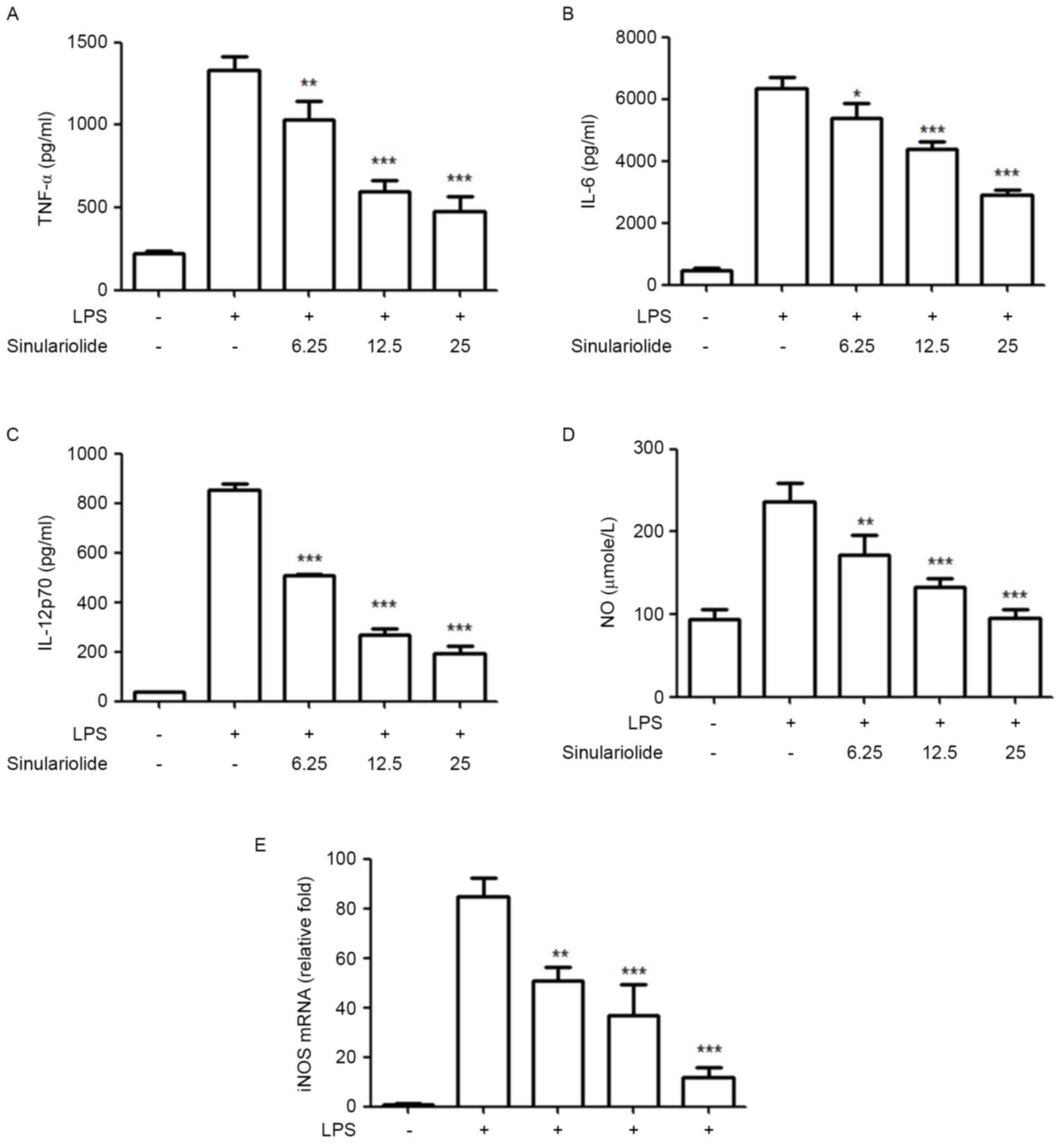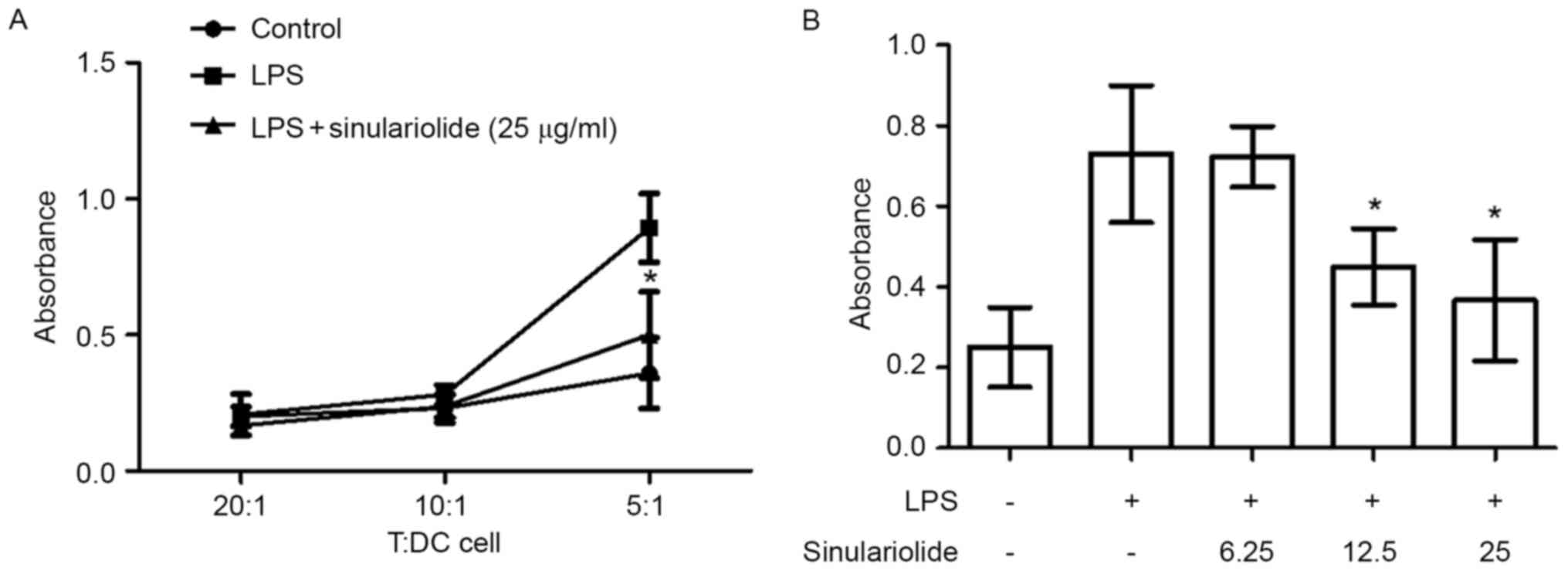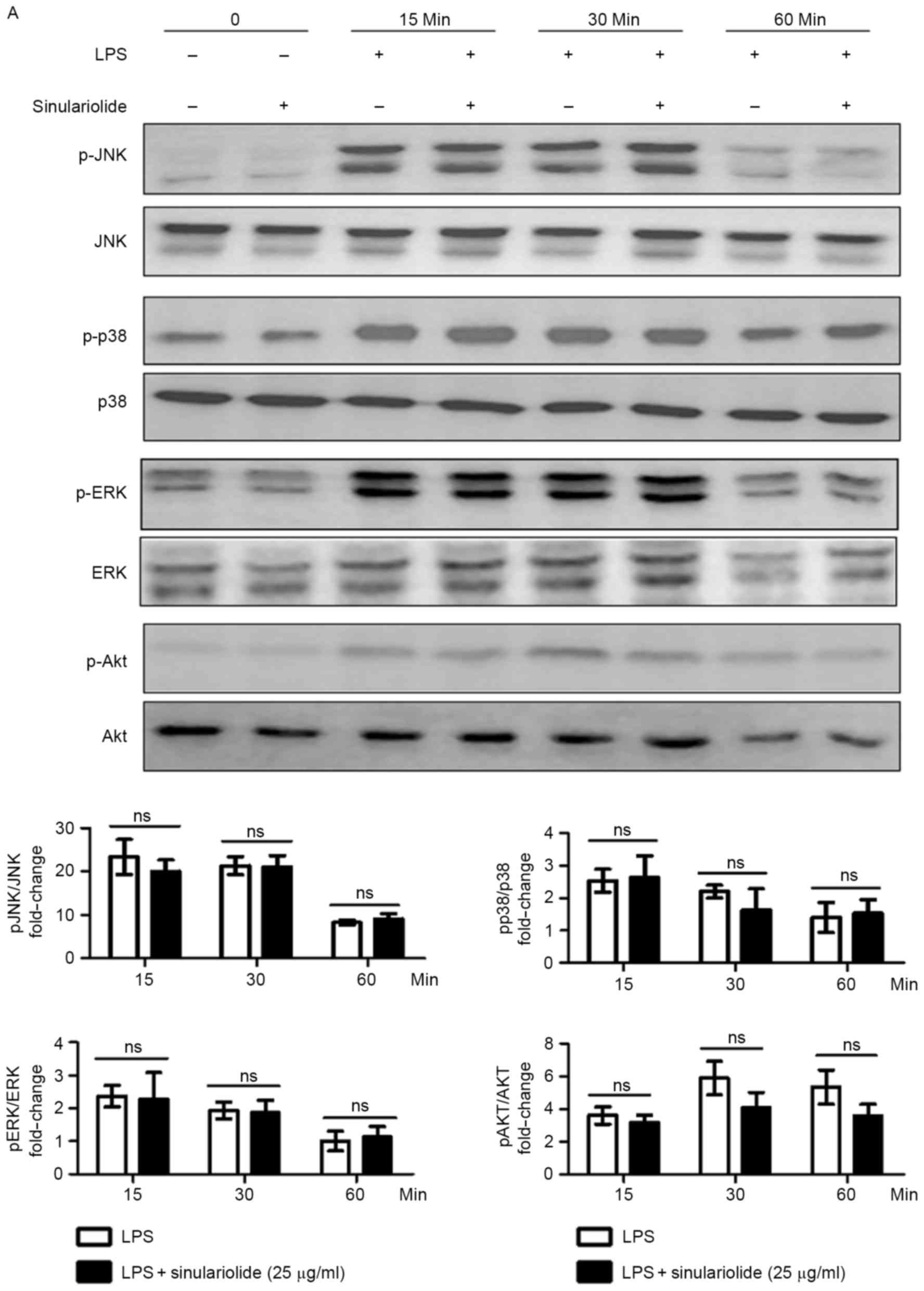Sinulariolide suppresses LPS‑induced phenotypic and functional maturation of dendritic cells
- Authors:
- Published online on: September 13, 2017 https://doi.org/10.3892/mmr.2017.7480
- Pages: 6992-7000
Abstract
Introduction
Dendritic cells (DCs) are bone marrow-derived professional antigen-presenting cells, which are critical in the regulation of adaptive immune responses. Immature DCs usually reside in peripheral tissues, expressing low levels of co-stimulatory molecules (CD80, CD86 and CD40), which disable them from activating naïve T cells. Immature DCs begin maturation following uptake of antigens and exposure to microbial agents or inflammatory mediators in peripheral tissues (1,2). The common characteristics of DC maturation include the upregulation of co-stimulatory molecules and major histocompatibility complex (MHC) class II on the cell surface, reduced capacity for antigen uptake, production of various inflammatory cytokines, and trafficking to secondary lymphoid organs through afferent lymphatic vessels. Subsequently, DCs present antigenic peptides and stimulate naïve antigen-specific T cells in lymphoid organs (3). Overall, the DCs are a feasible therapeutic target for the pharmacological modulation of immune responses, and the inhibition of DC maturation represents a strategy for modulating immune responses (4).
Natural compounds derived from marine organisms serve as potentially valuable sources for the identification of immunomodulatory drugs for application in the biotechnology and pharmaceutical industries. Cembrane diterpenoids and their cyclized derivatives are the most abundant metabolites of soft corals and vary substantially in structural complexity (5–7). These cembranes have a defensive function in resisting natural predators, including other corals and fish, and settlement by a variety of microorganisms (8,9). In addition, cembranes have been shown to possess different pharmacological activities in anti-inflammatory (10,11) and antitumor effects (12,13).
Sinulariolide, a cembrane-type diterpenoids, is an active compound isolated from the cultured soft coral Sinularia flexibilis. This compound has been reported to exhibit biological activities, which include antimicrobial (14) and anticancer activities (15–18). However, its effect on normal immune function remains to be fully elucidated. In the present study, whether sinulariolide can affect the maturation and functional properties of murine bone marrow-derived dendritic cells was investigated, and their underlying signaling pathways were examined.
Materials and methods
Mice and preparation of bone marrow-derived murine DCs
Female C57BL/6 mice (n=20; 6–8-weeks-old; 20–25 g) were purchased from the National Laboratory Animal Center (Taipei, Taiwan). The mice were housed under a controlled temperature (22±2°C) and humidity (45–65%) with a 12-h light/dark cycle, and free access food and water. Procedures governing the use and care of animals were performed according to the Institutional Animal Care and Use Committee guidelines and approved by the Bioethics Committee of National Chung-Hsing University (Taichung, Taiwan). The murine bone marrow-derived DCs were prepared as previously described (19).
Chemicals
Sinulariolide was isolated from the cultured soft coral Sinularia flexibilis according to previously reported procedures (20) and was provided by Dr Jui-Hsin Su (National Museum of Marine Biology and Aquarium, Pingtung, Taiwan). The stock solution was prepared at a concentration of 50 mg/ml in dimethyl sulfoxide (DMSO; Sigma Aldrich; Merck Millipore, Darmstadt, Germany). The working solution was freshly prepared by diluting with medium to desired concentrations.
Cell viability and apoptosis assay
The DCs (1×106) were prepared by treating with different concentrations of sinulariolide with or without 100 ng/ml LPS at 37°C for 24 h. Cytotoxicity was examined using a Cell Counting kit-8 (CCK-8; Dojindo Molecular Technologies, Inc., Kumamoto, Japan) according to the manufacturer's protocol. The absorbance was recorded on a microplate reader (Tecan Group Ltd., Männedorf, Switzerland) at a wavelength of 450 nm. For the analysis of apoptosis, the cells were stained with an Annexin V kit (Invitrogen; Thermo Fisher Scientific, Inc., Waltham, MA, USA), according to the manufacturer's protocol, and determined on an Accuri 5 flow cytometer (BD Biosciences, San Jose, CA, USA). The mean fluorescence intensity was calculated using C6 Accuri system software (BD Biosciences).
Flow cytometric analysis of surface molecules
The DCs (1×106) were treated with DMSO (0.1%) or sinulariolide for 1 h at 37°C, followed by LPS (100 ng/ml) stimulation at 37°C for 24 h. The expression of co-stimulatory markers CD40, CD80, and CD86 were detected on an Accuri 5 flow cytometer. Immunofluorescence staining for flow analysis was performed using mouse IgG anti-mouse CD11 mAb-FITC conjugated (1:100 dilution; cat. no. 553,801; BD Biosciences), mouse IgG anti-mouse CD80 mAb-phycoerythrin (PE) conjugated (1:100 dilution; cat. no. 104,708; BioLegend, Inc., San Diego, CA, USA), mouse IgG anti-mouse CD86 mAb-PE conjugated (1:100 dilution; cat. no. 105,008; BioLegend, Inc.), mouse IgG anti-mouse CD40 mAb-PE conjugated (1:100 dilution; cat. no. 12-0401-82; eBioscience; Thermo Fisher Scientific, Inc.) for 1 h at 4°C. The mean fluorescence intensity was calculated using C6 Accuri™ system software (BD Biosciences).
Cytokine and nitric oxide (NO) assay
Centrifugation was performed at 1,000 × g for 15 min at 4°C, then the levels of tumor necrosis factor (TNF)-α, interleukin (IL)-6 and IL-12p70 in the culture supernatants were determined using murine ELISA kits for TNF-α (cat. no. 900-K54), IL-6 (cat. no. 900-K50), and IL-12p70 (cat. no. 900-K97; PeproTech, Inc., London, UK) according to the manufacturer's protocol. The production of NO was assayed indirectly by measuring the levels of nitrite (NO2−) in the culture supernatants using a colorimeter assay based on the Griess reaction.
Reverse transcription-quantitative polymerase chain reaction (RT-qPCR) analysis
Total RNA isolation was performed using TRIzol (Invitrogen; Thermo Fisher Scientific, Inc.). Total RNA (2 µg; 10 µl) was reverse transcribed using M-MLV reverse transcriptase (Promega Corporation, Madison, WI, USA) to cDNA in a 20 µl final reaction volume containing M-MLV 5X Reaction Buffer (5 µl), 10 mM dNTP (1 µl), 500 µg/ml oligo dT15 primers (1 µl) and nuclease-free water (3 µl; all Promega Corporation), which were incubated at 42°C for 15 min. A total of 100 pg of cDNA was used to initiate qPCR, which was performed using the SYBR-Green PCR Master Mix (Applied Biosystems; Thermo Fisher Scientific, Inc.) in the ABI 7500 Fast Real-Time system (Applied Biosystems; Thermo Fisher Scientific, Inc.). The thermocycling conditions were as follows: 95°C for 5 min, followed by 40 cycles of 95°C for 15 sec and 60°C for 1 min. The primer pairs used were as follows: Inducible nitric oxide synthase (iNOS), forward 5′-ACATCGACCCGTCCACAGTAT-3′ and reverse 5′-CAGAGGGGTAGGCTTGTCTC-3′; GAPDH, forward 5′-CGTGTTCCTACCCCCAATGT-3′ and reverse 5′-TGTCATCATACTTGGCAGGTTTCT-3′. The 2−ΔΔCq method (21) was used to normalize transcription to GAPDH and calculate the fold induction relative to controls, which were without sinulariolide treatment.
DC-induced mixed lymphocyte reaction
The process of determining allogeneic mixed lymphocytes was performed as described previously (22). Briefly, enriched CD4+ T cells were negatively purified from the spleen of C57BL/6 mice using a CD4+ T-cell Isolation kit (Miltenyi Biotech, Bisley, UK). The DCs were treated with DMSO (0.1%) or sinulariolide (10 µM) in the presence or absence of LPS (100 ng/ml) for 18 h, which was added in graded doses to 2.5×105 allogeneic T cells in round-bottom 96-well plates. The plates were incubated at 37°C for 48 h and T cell proliferation was determined using a CCK-8 assay.
Western blot analysis
The DCs were seeded at a density of 2×106 cells per six-well plate and pretreated with DMSO (0.1%) or sinulariolide for 1 h, followed by stimulation with LPS (100 ng/ml) for the indicated durations. Western blot analysis was performed as described previously (22). In brief, the total cell lysates were extracted in RIPA lysis and extraction buffer (Thermo Fisher Scientific, Inc.). The protein concentrations were measured using a Bio-Rad protein assay kit (Bio-Rad Laboratories, Inc., Hercules, CA USA), following which 20 µg of protein was subjected to 10% SDS-PAGE and transferred onto nitrocellulose membranes. The membranes were incubated with antibodies against phosphorylated (p-)extracellular signal-regulated kinase (ERK; 1:1,000 dilution; cat. no. 4370), ERK (1:1,000 dilution; cat. no. 3192;), p-p38 (1:1,000 dilution; cat. no. 4631), p38 (1:1,000 dilution; cat. no. 8690), p-AKT (1:1,000 dilution; cat. no. 4060), AKT (1:1,000 dilution; cat. no. 4685) and inhibitor of NF-κB IκBα (1:1,000 dilution; cat. no. 4812; Cell Signaling Technology, Inc., Danvers, MA, USA) overnight at 4°C. The membranes were then incubated with horseradish peroxidase-labeled secondary antibody (1:2,000 dilution; cat. no. 111-035-003; Jackson ImmunoResearch Laboratories, Inc., West Grove, PA, USA) overnight at 4°C. The protein-antibody complexes were detected by enhanced chemiluminescence (GE Healthcare Life Sciences, Chalfont, UK), performed using a Hansor Luminescence Image system (Hansor, Taichung, Taiwan). The blots were quantified by densitometric analysis using ImageJ software version 1.47 (National Institutes of Health, Bethesda, MD USA).
Preparation of nuclear extracts and NF-κB activity assay
Nuclear extracts were prepared using NE-PER Nuclear and Cytoplasmic Extraction reagents (Pierce; Thermo Fisher Scientific, Inc.) according to the manufacturer's protocol. The samples were stored at −80°C for the analysis of NF-κB activity. The activity of NF-κB was measured in the nuclear protein extracts (15 µg) using the TransAM™ NF-κB p65 ELISA-based assay kit (Active Motif, Carlsbad, CA, USA), which is an ELISA-based method designed to detect NF-κB p65 subunit activation. The assay was performed according to the manufacturer's protocol and analyzed using a microplate reader at 450 nm, with a reference wavelength of 655 nm (Tecan Group Ltd.).
Statistical analysis
Data are expressed as the mean ± standard deviation of the indicated number of experiments. The statistical significance of differences between groups were examined using one way analysis of variables followed by Tukey's test or Student's t-test (GraphPad version 5 for Windows; GraphPad Software, Inc., San Diego, CA USA). P<0.05 was considered to indicate a statistically significant difference.
Results
Sinulariolide has no significant cytotoxic or apoptotic effects on DCs
The present study first evaluated the cytotoxicity of sinulariolide on DCs by treating DCs with different concentrations of sinulariolide in the presence or absence of LPS (100 ng/ml) for 24 h. No significant toxic effects were observed following treatment with sinulariolide in the concentration range of 6.25–25 µg/ml, however, 50 µg/ml sinulariolide significantly decreased cell viability (Fig. 1A). The expression of Annexin V and CD11c+ were then analyzed, in which sinulariolide (6.25–25 µg/ml) exerted minimal or no apoptotic effects on DCs (Fig. 1B and C). Therefore, sinulariolide concentrations <25 µg/ml were used in the following experiments.
Reduction in the expression of co-stimulatory molecules by sinulariolide
As co-stimulatory molecules are markers of the maturation of DCs (1,2), the present study investigated whether sinulariolide can alter the expression levels of CD40, CD80 and CD86 in LPS-treated DCs. As shown in Fig. 2, the expression levels of CD40, CD80 and CD86 were increased in immature DC following LPS treatment (100 ng/ml) for 24 h, and sinulariolide treatment effectively decreased the induction of co-stimulatory molecules in a dose-dependent manner.
Sinulariolide inhibits the secretion of proinflammatory mediators in LPS-induced maturation
Subsequently, the present study evaluated the inhibitory effect of sinulariolide on the production of proinflammatory cytokines and NO by LPS-stimulated DCs. The levels of TNF-α, IL-6, IL-12 and NO in the medium were measured following treatment of the immature DCs with sinulariolide for 1 h, followed by LPS (100 ng/ml) stimulation for 24 h. Despite the fact that the LPS-treated DCs showed markedly increased production of IL-12 p70, TNF-α, IL-6 and NO, compared with the untreated DCs, the results showed that sinulariolide suppressed this LPS-induced release of cytokines and NO in a dose-dependent manner (Fig. 3A-D). The present study also measured the mRNA levels of iNOS using RT-qPCR analysis to quantify the inhibitory effect of sinulariolide on NO, which is regulated by iNOS. The data, as shown in Fig. 3E, revealed that sinulariolide markedly decreased the mRNA level of iNOS in the LPS-stimulated DCs (Fig. 3E).
Sinulariolide suppresses the ability of LPS-stimulated DCs to activate allogeneic T cells
The effect of sinulariolide on DC-mediated allogeneic T cell proliferation was then examined. The LPS-stimulated DCs were pretreated with or without sinulariolide for 24 h and co-cultured with allogeneic spleen CD4+ T cells for 48 h prior to measuring T cell proliferation. As shown in Fig. 4A, the DCs treated with LPS induced more marked proliferative responses in allogeneic T cells, compared with the untreated DCs, when the T/DC cell ratio was 5:1. This effect was reduced by sinulariolide in the dose range of 6.25–25 µg/ml (Fig. 4B).
Sinulariolide represses the activation of NF-κB in LPS-stimulated DCs
To further elucidate the possible suppressive molecular mechanism of sinulariolide, the present study examined and identified the signaling pathways, which may be affected by sinulariolide in the LPS-stimulated DCs. As shown in Fig. 5A, ERK, c-Jun N-terminal kinase (JNK), p38 mitogen-activated protein kinases (MAPKs) and AKT were phosphorylated in the DCs upon stimulation, and sinulariolide appeared to partially reduce the LPS-induced phosphorylation of AKT at 30 min (P=0.08) and 60 min (P=0.07), compared with p-ERK, p-p38 and p-JNK. The expression of non-phosphorylated proteins were not affected by sinulariolide. The present study also analyzed the protein levels of IκB and the binding activity of NF-κB using a TransAM™ NF-κB assay. The results showed that sinulariolide decreased the degradation of IκB induced by LPS (Fig. 5B) and significantly inhibited the LPS-induced NF-κB binding activity of p65 (Fig. 5C). This suggested that sinulariolide repressed LPS-induced DC maturation via inhibition of the NF-κB pathway, which may further explain the inhibitory effect of sinulariolide on DC activation.
Discussion
The inhibitory effects of sinulariolide on the phenotype and functional activation of DCs were investigated in the present study. Sinulariolide has been shown to exert anticancer effects in various cancer cell types. In contrast to anticancer effects, the present study is the first, to the best of our knowledge, to report that sinulariolide is an immunomodulator, which can suppress the activation of DCs. The data suggested that sinulariolide had an inhibitory effect on the modulation of harmful and undesirable immune responses.
The immunogenic phenotype of mature DCs is functionally characterized by the upregulation of co-stimulatory markers (CD40, CD80 and CD86) and surface MHC molecules (23,24). These distinct molecules regulate the stimulatory capacity of DCs to activate allogeneic T cell proliferation. In the present study, sinulariolide significantly decreased the LPS-induced expression levels of CD40, CD80 and CD86 in a dose-dependent manner, indicating that DCs treated with sinulariolide were resistant to phenotypic maturation.
Another distinctive feature of DC maturation is the increased production of pro-inflammatory cytokines and NO, which have critical regulatory functions in inflammation, T cell differentiation and expansion. TNF-α, IL-6 and IL-12 are key pro-inflammatory cytokines involved in the pathogenesis of chronic inflammatory diseases. DC maturation induced by TNF-α augments Th1 cell differentiation, whereas IL-6 induces the differentiation of Th2 cells (25). The production of IL-12 by mature DCs is important in priming naïve CD4+ T cells to undergo Th1 differentiation (26). NO, synthesized by the enzyme NOS from L-arginine, is a potent signaling molecule, which is crucial in various physiological and pathophysiological processes (27). NO is also produced by DCs upon activation, thus providing a negative feedback mechanism to suppress lymphocyte proliferation and induce apoptosis of DCs (28,29). As a result, inhibiting the production of NO with the NOS inhibitor, NG-monomethyl arginine, can reduce this apoptotic process (28). Furthermore, iNOS is activated by bacterial infection and various immunogenic stimuli, including LPS, interferon-γ or TNF-α, enabling the generation of NO from DCs to regulate DC responsiveness in an autoregulatory feedback loop. The results of the present study showed that LPS significantly increased the expression of TNF-α, IL-6 and IL-12, and the release of NO/iNOS by DCs, and this increase was inhibited by sinulariolide, indicating the immunomodulatory role of sinulariolide in DC functions.
As the MAPK, phosphoinositide-3 kinase/Akt and NF-κB signaling pathways in DCs can be activated by LPS stimulation, it has been revealed that these signaling pathways are distinct, but overlapping, in the phenotypic maturation, cytokine production and functional activation of DCs. Among these pathways, NF-κB has a more important role, compared with that of JNK, in mediating LPS-stimulated DC phenotypic maturation (30,31). The differentiation of human monocytes into immature DCs has been determined by the activation of p38 MAPK (32). ERK and PI3 kinase/Akt are essential in LPS-stimulated DC survival (33). In the present study, it was observed that activation of the MAPK (ERK, p38 and JNK), AKT and NF-κB pathways were affected by LPS treatment, which was consistent with previous studies. However, pretreatment with sinulariolide exerted marked inhibitory effects on the degradation of IκB and activation of NF-κB in response to LPS stimuli, without inhibiting the LPS-induced phosphorylation of MAPK and AKT. These data suggested that the attenuation of LPS-stimulated maturation and inflammatory responses of DCs by sinulariolide were associated with downregulation of the NF-κB signaling pathway. However, the exact mechanisms underlying the suppressive effect of sinulariolide on LPS-stimulated DC activation requires further investigation.
Previous studies have shown that the bioactivity of sinulariolide can be enhanced by conjugating hyaluronan nanoparticles (34) and that hyaluronan nanoparticle/sinulariolide aggregates exert more potent anticancer effects on lung cancer cells, compared with sinulariolide alone. Conceivably, these techniques are likely to further facilitate the development of clinical applications of sinulariolide.
In conclusion, the results of the present study demonstrated that sinulariolide suppressed LPS-stimulated DC phenotypic maturation, cytokine and NO production, and co-stimulatory molecule expression. Therefore, sinulariolide may be utilized in the treatment of autoimmune and inflammatory disorders. These findings provide novel insight into the immunopharmacological functions of sinulariolide.
Acknowledgements
The present study was supported by Changhua Christian Hospital (grant nos. 103-CCH-IRP-003 and 103-CCH-ICO-001).
References
|
Li X, He X, Liu B, Xu L, Lu C, Zhao H, Niu X, Chen S and Lu A: Maturation of murine bone marrow-derived dendritic cells induced by Radix Glycyrrhizae polysaccharide. Molecules. 17:6557–6568. 2012. View Article : Google Scholar : PubMed/NCBI | |
|
Kim GY, Lee MY, Lee HJ, Moon DO, Lee CM, Jin CY, Choi YH, Jeong YK, Chung KT, Lee JY, et al: Effect of water-soluble proteoglycan isolated from Agaricus blazei on the maturation of murine bone marrow-derived dendritic cells. Int Immunopharmacol. 5:1523–1532. 2005. View Article : Google Scholar : PubMed/NCBI | |
|
English K, Barry FP and Mahon BP: Murine mesenchymal stem cells suppress dendritic cell migration, maturation and antigen presentation. Immunol Lett. 115:50–58. 2008. View Article : Google Scholar : PubMed/NCBI | |
|
Hackstein H and Thomson AW: Dendritic cells: Emerging pharmacological targets of immunosuppressive drugs. Nat Rev Immunol. 4:24–34. 2004. View Article : Google Scholar : PubMed/NCBI | |
|
Li G, Zhang Y, Deng Z, van Ofwegen L, Proksch P and Lin W: Cytotoxic cembranoid diterpenes from a soft coral Sinularia gibberosa. J Nat Prod. 68:649–652. 2005. View Article : Google Scholar : PubMed/NCBI | |
|
Yang B, Zhou XF, Lin XP, Liu J, Peng Y, Yang XW and Liu YH: Cembrane diterpenes chemistry and biological properties. Curr Org Chem. 16:1512–1539. 2012. View Article : Google Scholar | |
|
Chao CH, Chou KJ, Huang CY, Wen ZH, Hsu CH, Wu YC, Dai CF and Sheu JH: Bioactive cembranoids from the soft coral Sinularia crassa. Mar Drugs. 9:1955–1968. 2011. View Article : Google Scholar : PubMed/NCBI | |
|
Li Y, Gao AH, Huang H, Li J, Mollo E, Gavagnin M, Cimino G, Gu YC and Guo YW: Diterpenoids from the hainan soft coral sinularia parva. Helvetica Chim Acta. 92:1341–1348. 2009. View Article : Google Scholar | |
|
Coll JC, Price IR, Konig GM and Bowden BF: Algal overgrowth of alcyonacean soft corals. Mar Biol. 96:129–135. 1987. View Article : Google Scholar | |
|
Lu Y, Huang CY, Lin YF, Wen ZH, Su JH, Kuo YH, Chiang MY and Sheu JH: Anti-inflammatory cembranoids from the soft corals Sinularia querciformis and Sinularia granosa. J Nat Prod. 71:1754–1759. 2008. View Article : Google Scholar : PubMed/NCBI | |
|
Lu Y, Su JH, Huang CY, Liu YC, Kuo YH, Wen ZH, Hsu CH and Sheu JH: Cembranoids from the soft corals Sinularia granosa and Sinularia querciformis. Chem Pharm Bull (Tokyo). 58:464–466. 2010. View Article : Google Scholar : PubMed/NCBI | |
|
Liu CI, Chen CC, Chen JC, Su JH, Huang HH, Chen JY and Wu YJ: Proteomic analysis of anti-tumor effects of 11-dehydrosinulariolide on CAL-27 cells. Mar Drugs. 9:1254–1272. 2011. View Article : Google Scholar : PubMed/NCBI | |
|
Lin YS, Chen CH, Liaw CC, Chen YC, Kuo YH and Shen YC: Cembrane diterpenoids from the Taiwanese soft coral Sinularia flexibilis. Tetrahedron. 65:9157–9164. 2009. View Article : Google Scholar | |
|
Aceret TL, Coll JC, Uchio Y and Sammarco PW: Antimicrobial activity of the diterpenes flexibilide and sinulariolide derived from Sinularia flexibilis Quoy and Gaimard 1833 (Coelenterata: Alcyonacea, Octocorallia). Comp Biochem Physiol C Pharmacol Toxicol Endocrinol. 120:121–126. 1998. View Article : Google Scholar : PubMed/NCBI | |
|
Wu YJ, Neoh CA, Tsao CY, Su JH and Li HH: Sinulariolide suppresses human hepatocellular carcinoma cell migration and invasion by inhibiting matrix metalloproteinase-2/-9 through MAPKs and PI3K/Akt signaling pathways. Int J Mol Sci. 16:16469–16482. 2015. View Article : Google Scholar : PubMed/NCBI | |
|
Chen YJ, Su JH, Tsao CY, Hung CT, Chao HH, Lin JJ, Liao MH, Yang ZY, Huang HH, Tsai FJ, et al: Sinulariolide induced hepatocellular carcinoma apoptosis through activation of mitochondrial-related apoptotic and PERK/eIF2α/ATF4/CHOP pathway. Molecules. 18:10146–10161. 2013. View Article : Google Scholar : PubMed/NCBI | |
|
Li HH, Su JH, Chiu CC, Lin JJ, Yang ZY, Hwang WI, Chen YK, Lo YH and Wu YJ: Proteomic investigation of the sinulariolide-treated melanoma cells A375: Effects on the cell apoptosis through mitochondrial-related pathway and activation of caspase cascade. Mar Drugs. 11:2625–2642. 2013. View Article : Google Scholar : PubMed/NCBI | |
|
Neoh CA, Wang RY, Din ZH, Su JH, Chen YK, Tsai FJ, Weng SH and Wu YJ: Induction of apoptosis by sinulariolide from soft coral through mitochondrial-related and p38MAPK pathways on human bladder carcinoma cells. Mar Drugs. 10:2893–2911. 2012. View Article : Google Scholar : PubMed/NCBI | |
|
Li S, Lin YC, Ho CT, Lin PY, Suzawa M, Wang HC, Chu CL, Chen DY and Lin CC: Formulated extract from multiple citrus peels impairs dendritic cell functions and attenuates allergic contact hypersensitivity. Int Immunopharmacol. 20:12–23. 2014. View Article : Google Scholar : PubMed/NCBI | |
|
Hsieh PW, Chang FR, McPhail AT, Lee KH and Wu YC: New cembranolide analogues from the formosan soft coral Sinularia flexibilis and their cytotoxicity. Nat Prod Res. 17:409–418. 2003. View Article : Google Scholar : PubMed/NCBI | |
|
Livak KJ and Schmittgen TD: Analysis of relative gene expression data using real-time quantitative PCR and the 2(-Delta Delta C(T)) method. Methods. 25:402–408. 2001. View Article : Google Scholar : PubMed/NCBI | |
|
Lin CC, Chu CL, Ng CS, Lin CY, Chen DY, Pan IH and Huang KJ: Immunomodulation of phloretin by impairing dendritic cell activation and function. Food Funct. 5:997–1006. 2014. View Article : Google Scholar : PubMed/NCBI | |
|
Caux C, Massacrier C, Vanbervliet B, Dubois B, Van Kooten C, Durand I and Banchereau J: Activation of human dendritic cells through CD40 cross-linking. J Exp Med. 180:1263–1272. 1994. View Article : Google Scholar : PubMed/NCBI | |
|
Pinchuk LM, Polacino PS, Agy MB, Klaus SJ and Clark EA: The role of CD40 and CD80 accessory cell molecules in dendritic cell-dependent HIV-1 infection. Immunity. 1:317–325. 1994. View Article : Google Scholar : PubMed/NCBI | |
|
Diehl S and Rincón M: The two faces of IL-6 on Th1/Th2 differentiation. Mol Immunol. 39:531–536. 2002. View Article : Google Scholar : PubMed/NCBI | |
|
Heufler C, Koch F, Stanzl U, Topar G, Wysocka M, Trinchieri G, Enk A, Steinman RM, Romani N and Schuler G: Interleukin-12 is produced by dendritic cells and mediates T helper 1 development as well as interferon-gamma production by T helper 1 cells. Eur J Immunol. 26:659–668. 1996. View Article : Google Scholar : PubMed/NCBI | |
|
Moncada S, Palmer RM and Higgs EA: Nitric oxide: Physiology, pathophysiology, and pharmacology. Pharmacol Rev. 43:109–142. 1991.PubMed/NCBI | |
|
Bonham CA, Lu L, Li Y, Hoffman RA, Simmons RL and Thomson AW: Nitric oxide production by mouse bone marrow-derived dendritic cells: Implications for the regulation of allogeneic T cell responses. Transplantation. 62:1871–1877. 1996. View Article : Google Scholar : PubMed/NCBI | |
|
Lu L, Bonham CA, Chambers FG, Watkins SC, Hoffman RA, Simmons RL and Thomson AW: Induction of nitric oxide synthase in mouse dendritic cells by IFN-gamma, endotoxin, and interaction with allogenic T cells: Nitric oxide production is associated with dendritic cell apoptosis. J Immunol. 157:3577–3586. 1996.PubMed/NCBI | |
|
Neves BM, Cruz MT, Francisco V, Garcia-Rodriguez C, Silvestre R, Cordeiro-da-Silva A, Dinis AM, Batista MT, Duarte CB and Lopes MC: Differential roles of PI3-kinase, MAPKs and NF-kappaB on the manipulation of dendritic cell T(h)1/T(h)2 cytokine/chemokine polarizing profile. Mol Immunol. 46:2481–2492. 2009. View Article : Google Scholar : PubMed/NCBI | |
|
Rescigno M, Martino M, Sutherland CL, Gold MR and Ricciardi-Castagnoli P: Dendritic cell survival and maturation are regulated by different signaling pathways. J Exp Med. 188:2175–2180. 1998. View Article : Google Scholar : PubMed/NCBI | |
|
Ardeshna KM, Pizzey AR, Devereux S and Khwaja A: The PI3 kinase, p38 SAP kinase, and NF-kappaB signal transduction pathways are involved in the survival and maturation of lipopolysaccharide-stimulated human monocyte-derived dendritic cells. Blood. 96:1039–1046. 2000.PubMed/NCBI | |
|
Xie J, Qian J, Yang J, Wang S, Freeman ME III and Yi Q: Critical roles of Raf/MEK/ERK and PI3K/AKT signaling and inactivation of p38 MAP kinase in the differentiation and survival of monocyte-derived immature dendritic cells. Exp Hematol. 33:564–572. 2005. View Article : Google Scholar : PubMed/NCBI | |
|
Hsiao KY, Wu YJ, Liu ZN, Chuang CW, Huang HH and Kuo SM: Anticancer effects of sinulariolide-conjugated hyaluronan nanoparticles on lung adenocarcinoma cells. Molecules. 21:2972016. View Article : Google Scholar : PubMed/NCBI |



